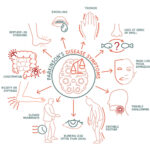The incidence of chronic hypertension in pregnancy in the United States doubled between 2007 and 2021, yet only around 60% of those affected received treatment with antihypertensive drugs, according to a study supported by the National Institutes of Health (NIH). Published in the journal Hypertension, the study analysed data from nearly 2 million pregnancies and attributed the rise to increasing maternal age, rising obesity rates, and other demographic shifts.
Lead researcher Stephanie Leonard, PhD, an epidemiologist at Stanford University School of Medicine, highlighted the critical implications of these findings, particularly concerning the high maternal mortality rates associated with chronic hypertension during pregnancy. Despite effective treatment options, the study underscored significant gaps in managing this severe condition.
Chronic hypertension during pregnancy is characterised by sustained high blood pressure (140/90 mm Hg or higher) either before pregnancy or within the first 20 weeks of gestation. It poses considerable risks to both maternal and foetal health, including organ damage, increased likelihood of preterm birth, and low birth weight. Untreated chronic hypertension can also lead to fatal complications if left undetected.
The study’s findings hold particular relevance for Black, American Indian, and Alaska Native populations, who experience disproportionately high rates of adverse maternal health outcomes and pregnancy-related deaths. Candice A. Price, Ph.D., a program director at NHLBI focusing on women’s health research, emphasised the urgent need to address these disparities and improve detection and treatment strategies, especially among high-risk groups.
Using a comprehensive dataset of U.S. commercial insurance claims spanning from 2007 to 2021, researchers observed a more than twofold increase in chronic hypertension prevalence among pregnant individuals, rising from 1.8% in 2008 to 3.7% in 2021. Despite this increase, the percentage of those receiving antihypertensive medications remained relatively stagnant, increasing only from 58% to 60% over the study period.
While the exact reasons behind the surge in chronic hypertension were not the primary focus of the study, Leonard noted that trends mirrored broader hypertension patterns observed in the general adult population and in previous studies covering different time frames. Factors such as advanced maternal age at childbirth and escalating obesity rates were identified as potential contributors to this trend.
The study also evaluated the impact of updated hypertension guidelines introduced by the American College of Cardiology and the American Heart Association in 2017, which lowered the diagnostic thresholds for hypertension in adults. However, the researchers found no immediate association between these guidelines and the observed trends during the 2008-2021 period studied. Leonard suggested that future analyses reveal the influence of the guidelines in subsequent years.
To effectively manage hypertension during pregnancy, experts recommend regular blood pressure monitoring, adherence to prescribed medications, and frequent consultations with healthcare providers. These measures are crucial for minimising the risks associated with chronic hypertension and ensuring optimal maternal and foetal outcomes.
While chronic hypertension prevalence in pregnancy has risen significantly in recent years, there remains a pressing need for enhanced detection, treatment, and management strategies to mitigate its adverse effects on maternal health. Addressing these challenges comprehensively is essential for reducing maternal mortality rates and improving overall pregnancy outcomes in the United States.
More information: Stephanie A. Leonard et al, Chronic Hypertension During Pregnancy: Prevalence and Treatment in the United States, 2008–2021, Hypertension. DOI: 10.1161/HYPERTENSIONAHA.124.22731
Journal information: Hypertension Provided by National Heart Lung & Blood Institute








